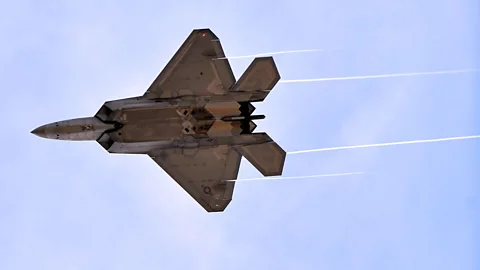The latest tech weapons the US might deploy in Syria

 Getty Images
Getty ImagesUS military commanders often see conflicts as opportunities to use recently developed technology. Here are the latest weapons or systems that may be used and why - from microwave to cyber weapons.
Military action against Syria may have been put on hold, at least for now. But as the US military has been gearing up for operations in Syria in response to the Assad regime’s alleged use of chemical weapons, there has been growing speculation over the weaponry it will use. Some are obvious. The USS Nimitz and other ships have already been ordered into the region, suggesting that if a strike were to happen the use of F-18 strike fighter jets and Tomahawk long-range cruise missiles may be involved.
But, as previous military campaigns have shown, US military commanders often see new conflicts as an opportunity to use recently developed weapons. In some cases, these offer unique capabilities, such as destroying stockpiles of chemical weapons. Employing exotic new weaponry can also offer the opportunity to demonstrate that the investment of significant sums was money well spent. Here are some of the latest weapons or types of systems that may end up being used:
Agent Defeat Weapons
The US military has for many years been working on weapons designed specifically to target sites believed to house weapons of mass destruction, such as chemical or biological weapons. Using conventional weapons on such facilities runs the risk of spreading highly toxic substances, so the Pentagon has funded a number of what are called “agent defeat weapons”. The Air Force has confirmed it has two such systems in its inventory. The CBU-107 Passive Attack Weapon (PAW) is essentially a weapon casing packed with thousands of penetrator rods with no explosives. Designed for targets where heat might be dangerous, the idea is that a 450-kg (990-pound) bomb scatters thousands of rods from mid air over an area of 60 metres, which can penetrate containers filled with chemical weapons, and allow them to drain into the ground to minimise dispersal. The BLU-119/B CrashPad is a more explosive, rapid option. The CrashPad ruptures chemical weapons stores with blast or shrapnel and contains white phosphorous to incinerate chemical agents.
F-22
The US’s most sophisticated fighter, the F-22 Raptor, has yet to see combat. While Air Force officials have argued the highly manoeuvrable aircraft with stealth technology would be useful in dealing with Syria’s sophisticated air defence systems and surface-to-air missiles, critics point out it is primarily designed as an air-to-air fighter. Another issue is that flight restrictions on the F-22 were lifted just earlier this year after concerns over pilot oxygen deprivation, and upgrades to the fleet designed to address that issue won’t be completed until next year. Despite this, if the Air Force pushes for it, the F-22 may still get its first outing during the forthcoming conflict.
Spy Satellites
Satellites have long been used to track weapons of mass destruction, and the US has been investing heavily in new eyes in the sky. Last week, the National Reconnaissance Office announced the launch of its latest spy satellite, though no details were provided (as is typical for such launches). Experts suspect it is nothing extraordinary: just another in the existing KH-11 satellite constellation, which uses electro-optical imaging. But officials have also hinted at new surveillance capabilities, and documents leaked by Edward Snowden, the former National Security Agency contractor, and published by the Washington Post, reveal a host of top-secret satellites, such as the intriguingly named Quasar and Intruder. The documents, which the Washington Post redacted, provide no specific details on these satellites’ capabilities, however.
High Power Microwave Weapons
Imagine a weapon that can knock out all the computers in a Syrian military command centre without killing a single person. That’s the idea behind high power microwave weapons, which are designed to destroy electronics without causing any physical damage. Last year, Boeing released a video of its High Power Microwave Advanced Missile Project (Champ) - a missile that essentially fries circuits by causing a surge in power. In the short film, Champ was seen taking out a bank of computers. While the system is likely to be still several years away from being fielded, the Air Force has conducted classified work in high power microwaves for years, and some suspect it already has such weapons available.
Cyber Weapons
In 2010 the Pentagon set up the US Cyber Command to coordinate and conduct both defensive and offensive military operations in cyberspace. The Stuxnet virus, designed to destroy Iran’s uranium-enriching gas centrifuges, and first identified that same year, is believed to have been a demonstration of the US’s abilities to wage war by attacking enemy computer systems. There have already been calls for the White House to launch cyber operations against Syria. Targets could be military, such as air defences, or critical infrastructure, such as the electricity grid or financial systems. Some cyber attacks use malware (malicious software) to gain access to enemy systems in order to either steal sensitive information or gain control of them. Information can be harvested using key logging software that tracks keystrokes, for example. Spoofing involves forging packets of data so that they look as if they come from legitimate sources. There are also data-driven attacks. A common form is the denial of service (DDOS) attack which aims to cripple systems by bombarding them with data, usually using bot-nets – large numbers of compromised computers.
If you would like to comment on this article or anything else you have seen on Future, head over to our Facebook page or message us on Twitter.
